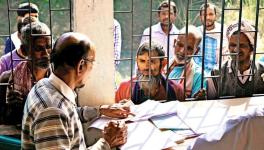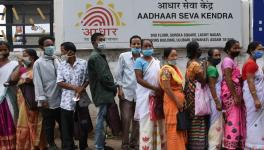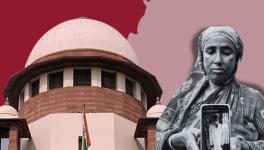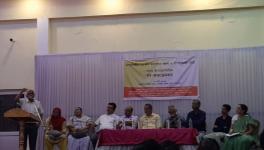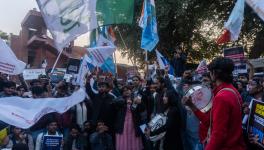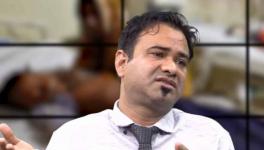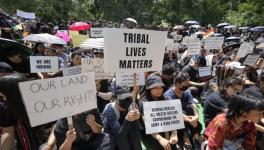Ahead of 2019 Polls, Demands for NRC and ILP in Sikkim
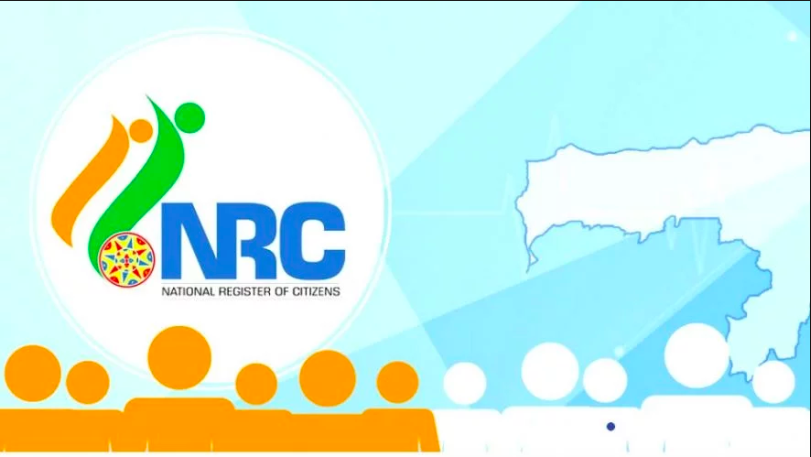
Representational image, NRC logo for Assam.
Some groups from Sikkim have recently begun to demand that Sikkim enumerate a National Register of Citizens (NRC), implement an Inner Line System – commonly referred to as the Inner Line Permit (ILP), and restore the seat ratio in the Assembly. Reports have named the groups such as Sikkim Indigenous Lepcha Tribal Association (SILTA), the Sikkim Bhutia Lepcha Apex Committee (SIBLAC) and the Nationalist Sikkim United Organisation (NSUO). These demands spring from a growing perception that Sikkim is affected by an influx of ‘outsiders’. However, each of the demands, including this growing perception requires some introspection.
Perhaps, what has fuelled this perception of an influx is the growing population of migrants in urban areas of Sikkim. What may have shocked some was that when the Sikkim Krantikari Morcha’s (SKM) head, Prem Singh Tamang (Golay) was released from prison after serving a sentence for financial misdeeds, he organised rallies in each of the state’s four districts. The ruling Sikkim Democratic Front (SDF) then launched counter rallies in each district, since the SKM is the strongest opposition party in the state. According to murmurs in Namchi, in South Sikkim, while the SKM attracted a sizeable number of ‘locals’, which the SDF rally appeared to lack.
Also Read | Sikkim's Politics has a Leadership Void
Mona Chettri, in 2017, had noted in a study on Chungthang in North Sikkim district, that the town had become ghettoised with locals getting squeezed between the Army cantonment, and the migrant workers of the hydro-power project. Another irritant for the locals is a Gurdwara set up by the Army that insists the name of Chungthang is actually Changi-thang, and was visited by Guru Nanak on his way to Tibet. It is clear that an uneasiness is growing in Sikkim. Such an outcome is understandable as in a democracy, numbers count, and allegations of ‘vote-bank politics’ are quite common. However, the problem arises with the groups that have been raising these demands.
Sikkimese society, though miniscule in number, is fractured across too many lines, be it ethnic or religious. The groups that have raised these demands are perceived by most of the Nepali Sikkimese as being ‘anti-Nepali’. Thus, the demands themselves will be seen with apprehension and suspicion by the Nepali-speaking community. Regardless of these irritants, the demands raised are impossible to fulfil unless Sikkim’s relationship with India is reviewed.
Also Read | Learning from History: Renegotiating the India Nepal Treaty
National Register of Citizens
The first issue that has to be settled on the NRC demand is the cut-off year. Sikkim was officially coerced into the Indian Union on May 16, 1975. Therefore, this could serve as a starting point. However, the problem is that the Sikkim Subjects Register created under the Sikkim Subjects Regulation, 1961 was not a complete register of names. Due to logistical difficulties, many names may have been left out of it. Therefore, following the ‘merger’ of Sikkim, the government issued certificates of identification (COI) to persons who were left out based on land ownership, cultivation, their relatives’ inclusion in the Register, and most importantly, on the basis of the Gram Panchayat’s recommendation. Both documents are hereditary, but only through the male lineage. Therefore, choosing a cut-off year is as difficult as determining which identity document should serve as the basis.
An additional issue arises with regard to migrants from India who had refused Sikkim Subject Certificates (SSC), and subsequently were ineligible for receiving COIs as well. For someone unaware, it may seem strange that Sikkim has an additional layer of citizenship protocol. However, the continued existence of SSC is mandated by clause k of Article 371F of the Constitution. This provision extends the life of all old laws that were in force in Sikkim, until amended or repealed by a competent legislature or other competent authority.
Also Read | Why Has a Little-known Group Labelled April 30 A Black Day?
Restoration of the Seat Ratio
The seat restoration issue of late has gained a new momentum along with the Limboo-Tamang seat issue. Both communities became Scheduled Tribes (ST) in 2002, despite belonging to the larger Nepali-speaking community. At present, they are demanding that seats be reserved for them in the state assembly. Allowing this is more complicated than it seems.
Firstly, the Sikkim Assembly has only 32 seats. At the time of ‘merger’, the break-up of seat distribution in Sikkim was that the Bhutia and Lepcha communities together and the Nepali community would have 15 seats each, whereas one seat would be reserved for the Sangha (the Buddhist clergy) and the Scheduled Castes (SC) each. However, by an Act of Parliament in 1980, the Nepali seats were converted into ‘general seats’ and the Bhutia seats were reduced. The present break-up is 12 seats for the Bhutia and Lepcha communities, two seats for the SCs and one seat for the Sangha. However, since Nepali Sikkimese constitute the bulk of the state’s population – around 70 per cent – converting two general seats into reserved seats for the Limboo and Tamang communities is not tenable. On the other hand, the Bhutia and Lepcha communities are opposed to having their seat share further reduced.
Unlike what may be portrayed, the seats reserved for the Bhutias and Lepchas have not been done on the basis of their ‘backwardness’ as tribals, but rather on the basis of ethnicity. This too finds its origin in the Tripartite May 8 Agreement of 1973 between the Government of India, the Chogyal and the political parties. Some sections of Sikkim feel that by virtue of the Government of Sikkim Act, 1974 – which gave legal effect to the 8th May Agreement of 1973 – the seat distribution among the three broad communities are protected by clause k of Article 371F. However, the Act does not specify seat distribution, and instead lays down in broad terms the power-sharing domains of the Chogyal, the Assembly and the Executive Council. Additionally, as its origin lies in the 8th May Agreement, the Act will be struck – through extension – by clause m of Article 371F.
Also Read | How Sikkim Became the 22nd State of India
Clause m bars all Courts in India from hearing any dispute arising out of any “treaty, agreement, engagement or other similar instrument relating to Sikkim which was entered into or executed before the appointed day and to which the Government of India or any of its predecessor Governments was a party, but nothing in this clause shall be construed to derogate from the provisions of Article 143”. This implies that unless the president were to refer the matter – in a non-justiciable manner – the Supreme Court cannot peruse these old documents.
Another issue is that by virtue of clause f, seat distribution is solely in the hands of the Parliament. Therefore, such changes can only be made by passing a Bill to the effect. Therefore, from the perspective of the Limboo–Tamang seat issue, the only authority capable of doing anything about it is the Parliament. Going by the previous delimitation wherein the Nepali seats were abolished, it is unlikely that Parliament would take the matter very seriously.
Inner Line Permit System
The ILP demand is an old demand in the Northeast. What was originally intended as a means of excluding the tribes from territories occupied by the British, has now become a tool for communities to regulate the entry of & the ‘outsiders’. Similar demands have been raised at varying intervals across the Northeast. In Manipur, these demands took a violent turn in 2015.
However, the ILP by itself is no insulation from ‘outsiders’. The ‘outsiders’ cannot be barred from residing or carrying out trade as these form a part of Article 19 of the Constitution. Further, they cannot be barred from voting, as it is a fundamental and democratic of citizens. Therefore, implementing the ILP in Sikkim will not have much effect in controlling the alleged ‘influx’. Besides, Sikkim already has a system in place where Restricted Area Permits (RAP) are issued to the foreigners who wish to enter the state. Nationals belonging to Pakistan, Bangladesh, China, Myanmar and Nigeria can be issued RAPs on the prior approval of the Ministry of Home Affairs. The permits can be obtained at the border check-posts at Melli and Rangpo. Therefore, legal means of regulating entry into Sikkim already exist. Neither replacing the existing system nor adding an additional layer to it will change the existing ground reality.
Also Read | Protecting the Land in the Northeast
What thus becomes apparent is that the stumbling block for the NRC and seat delimitation demand is the existence of Article 371F. However, repealing the Article will affect Sikkim’s relationship with the Indian Union on two accounts. Firstly, the people of Sikkim deeply believe that the Article provides ‘protections’ to Sikkim and the Sikkimese people. However, abolishing the previous seat arrangement was done without affecting the provision despite affecting the polity of Sikkim. Secondly, if Article 371F were to be repealed, the Indo Sikkim Treaty of 1950 will legally have to come back into force. Though in practice, it is highly unlikely that the Treaty will be respected by the Indian Union, particularly when it was completely disregarded in 1975.
Get the latest reports & analysis with people's perspective on Protests, movements & deep analytical videos, discussions of the current affairs in your Telegram app. Subscribe to NewsClick's Telegram channel & get Real-Time updates on stories, as they get published on our website.










